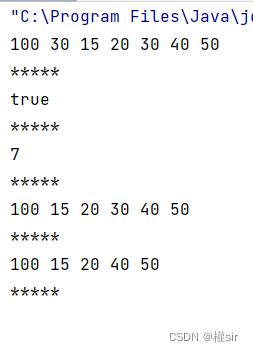Java中的链表
文章目录
- 前言
- 一、链表的概念及结构
- 二、单向不带头非循坏链表的实现
-
- 2.1打印链表
- 2.2求链表的长度
- 2.3头插法
- 2.4尾插法
- 2.5任意位置插入
- 2.6查找是否包含某个元素的节点
- 2.7删除第一次出现这个元素的节点
- 2.8删除包含这个元素的所以节点
- 2.9清空链表
- 单向链表的测试
- 三、双向不带头非循坏链表的实现
-
- 3.1打印双向链表
- 3.2求双向链表的长度
- 3.3头插法
- 3.4尾插法
- 3.5任意位置插入
- 3.6查找是否包含某个元素的节点
- 3.7删除第一次出现这个元素的节点
- 3.7删除包含这个元素的所有节点
- 3.9清空双向链表
- 双向链表的测试
- LinkedList的遍历方式
- 四、ArrayList和LinkedList的区别
前言
在前面我们已经学习了关于顺序表ArrayList的一些基本操作。通过源码知道,ArrayList底层使用数组来存储元素,由于其底层是一段连续空间,当在ArrayList任意位置插入或者删除元素时,就需要将后序元素整体往前或者往后搬移,时间复杂度为O(n),效率比较低,因此ArrayList不适合做任意位置插入和删除比较多的场景。因此:java集合中又引入了LinkedList,即链表结构
一、链表的概念及结构
链表是一种物理存储结构上非连续存储结构,数据元素的逻辑顺序是通过链表中的引用链接次序实现的
注意:
1.链式结构在逻辑上是连续的,但是在物理上不一定连续
2.现实中的结点一般都是从堆上申请出来的
3.从堆上申请的空间,是按照一定的策略来分配的,两次申请的空间可能是连续,也可能不连续
链表的结构有8种样式:
单向带头循坏、单向带头非循坏、单向不带头循坏、单向不带头非循坏
双向带头循坏、双向带头非循坏、双向不带头循坏、双向不带头非循坏
这里我们主要学习以下两中结构:
单向不带头非循坏

LinkedList底层使用的就是双向不带头非循坏

二、单向不带头非循坏链表的实现
2.1打印链表
不带参数的打印
public void display() {
ListNode cur = head;
if(cur != null) {//遍历完所以节点
System.out.print(cur.val+" ");
cur = cur.next;
}
System.out.println();
}
带参数的打印
public void display(ListNode newHead) {
ListNode cur = newHead;
if(cur != null) {
System.out.print(cur.val+" ");
cur = cur.next;
}
System.out.println();
}
2.2求链表的长度
public int size(){
ListNode cur = head;
int count = 0;
while (cur != null) {
count++;
cur = cur.next;
}
return count;
}
2.3头插法
public void addFirst(int data){
ListNode node = new ListNode(data);
node.next = head;
head = node;
}
2.4尾插法
public void addLast(int data){
ListNode node = new ListNode(data);
if(head == null) {
head = node;
}else {
ListNode cur = head;
while (cur.next != null) {//走到最后一个节点的位置
cur = cur.next;
}
cur.next = node;
}
}
2.5任意位置插入
在任意位置插入时我们要判断该位置是否合法,不合法的时候要抛一个异常
public void addIndex(int index,int data){
if(index < 0 || index > size()) {
throw new IndexException("index位置不合法:"+index);
}
ListNode node = new ListNode(data);
if(head == null) {
head = node;
return;
}
if(index == 0) {
addFirst(data);
return;
}
if(index == size()) {
addLast(data);
return;
}
//中间插入
ListNode cur = serchIndex(index);
node.next = cur.next;
cur.next = node;
}
找要添加节点位置的前一个节点
public ListNode serchIndex(int index) {
ListNode cur = head;
int count = 0;
while (count != index-1) {
cur = cur.next;
count++;
}
return cur;
}
2.6查找是否包含某个元素的节点
遍历这个链表找是否与这个元素相同
public boolean contains(int key){
ListNode cur = head;
while (cur != null) {
if(cur.val == key) {
return true;
}
cur = cur.next;
}
return false;
}
2.7删除第一次出现这个元素的节点
public void remove(int key){
if(head == null) {
return;
}
if(head.val == key) {
head = head.next;
return;
}
ListNode cur = findKey(key);
if(cur == null) {
return;//没有要删除的元素
}
ListNode del = cur.next;
cur.next = del.next;
}
要删除节点的前一个节点
public ListNode findKey(int key) {
ListNode cur = head;
while (cur.next != null) {
if(cur.next.val == key) {
return cur;
}else {
cur = cur.next;
}
}
return null;
}
2.8删除包含这个元素的所以节点
public void removeAllKey(int key){
if(head == null) {
return;
}
ListNode prev = head;
ListNode cur = head.next;
while (cur != null){
if(cur.val == key) {
prev.next = cur.next;
cur = cur.next;
}else {
prev = cur;
cur = cur.next;
}
}
//除了头节点外,其余都删完了
if(head.val == key) {
head = head.next;
}
}
2.9清空链表
清空链表只需要把头节点置为空
public void clear() {
head = null;
}
单向链表的测试
public class Test {
public static void main(String[] args) {
MySingleList list = new MySingleList();
list.addLast(30);//尾插
list.addLast(20);
list.addLast(30);
list.addLast(40);
list.addLast(50);
list.addFirst(100);//头插
list.addIndex(2,15);//任意位置插入
list.display();
System.out.println("*****");
System.out.println(list.contains(20));//查看是否包含某个节点
System.out.println("*****");
System.out.println(list.size());//求链表长度
System.out.println("*****");
list.remove(30);//删除第一个出现的节点
list.display();
list.removeAllKey(30);//删除包含这个元素的所以节点
System.out.println("*****");
list.display();
System.out.println("*****");
list.clear();//清空链表
list.display();
}
}
三、双向不带头非循坏链表的实现
3.1打印双向链表
public void display(){
ListNode cur = head;
while (cur != null) {
System.out.print(cur.val+" ");
cur = cur.next;
}
System.out.println();
}
3.2求双向链表的长度
public int size(){
int count = 0;
ListNode cur = head;
while (cur != null) {
count++;
cur = cur.next;
}
return count;
}
3.3头插法
public void addFist(int data) {
ListNode node = new ListNode(data);
if(head == null) {//一个节点都没有的情况
head = node;
last = node;
}else {
node.next = head;
head.prev = node;
head = node;
}
}
3.4尾插法
public void addLast(int data) {
ListNode node = new ListNode(data);
if(head == null) {//一个节点都没有的情况
head = node;
last = node;
}else {
last.next = node;
node.prev = last;
last = node;
}
}
3.5任意位置插入
这里的插入与单向链表一样也需要判断该位置的合法性,不合法时抛一个异常
public void addIndex(int index,int data) {
if(index < 0 || index > size()) {
throw new IndexException("双向链表中index的位置不合法:"+index);
}
if(index == 0) {
addFist(data);
}
if(index == size()) {
addLast(data);
}
ListNode cur = findIndex(index);
ListNode node = new ListNode(data);
node.next = cur;
cur.prev.next = node;
node.prev = cur.prev;
cur.prev = node;
}
要添加节点的位置
public ListNode findIndex(int index) {
ListNode cur = head;
if(index != 0) {
cur = cur.next;
index --;
}
return cur;
}
3.6查找是否包含某个元素的节点
public boolean contains(int key){
ListNode cur = head;
while (cur != null) {
if(cur.val == key) {
return true;
}
cur = cur.next;
}
return false;
}
3.7删除第一次出现这个元素的节点
因为数据结构是一门逻辑性非常严谨的学科,所以这里的删除需要考虑多种因素
public void remove(int key){
ListNode cur = head;
while (cur != null) {
if(cur.val == key) {
if(cur == head) {
head = head.next;
if (head != null) {
head.prev = null;
}else {
//只有一个节点,而且是需要删除的节点
last = null;
}
}else {
//删除中间节点
if(cur.next != null) {
cur.next.prev = cur.prev;
cur.prev.next = cur.next;
}else {
//删除尾巴节点
cur.prev.next = cur.next;
last = last.prev;
}
}
return;
}
cur = cur.next;
}
}
3.7删除包含这个元素的所有节点
public void remove(int key){
ListNode cur = head;
while (cur != null) {
if(cur.val == key) {
if(cur == head) {
head = head.next;
if (head != null) {
head.prev = null;
}else {
//只有一个节点,而且是需要删除的节点
last = null;
}
}else {
//删除中间节点
if(cur.next != null) {
cur.next.prev = cur.prev;
cur.prev.next = cur.next;
}else {
//删除尾巴节点
cur.prev.next = cur.next;
last = last.prev;
}
}
}
cur = cur.next;
}
}
3.9清空双向链表
public void clear(){
ListNode cur = head;
while (cur != null) {
ListNode curNext = cur.next;
cur.prev = null;
cur.next = null;
cur = cur.next;
}
head = null;//头节点置空
last = null;//尾巴节点置空
}
双向链表的测试
public class Test {
public static void main(String[] args) {
MyLinkedList myLinkedList = new MyLinkedList();
myLinkedList.addLast(12);//尾插法
myLinkedList.addLast(45);
myLinkedList.addLast(34);
myLinkedList.addLast(45);
myLinkedList.addFist(56);//头插法
myLinkedList.addIndex(2,15);//任意位置插入
myLinkedList.display();
System.out.println(myLinkedList.size());//求双向链表的长度
System.out.println("******");
System.out.println(myLinkedList.contains(23));//查找是否包含某个元素的节点
System.out.println("******");
myLinkedList.remove(45);//删除第一次出现这个元素的节点
myLinkedList.display();
System.out.println("******");
myLinkedList.removeAllKey(45);//删除包含这个元素的所以节点
myLinkedList.display();
System.out.println("******");
myLinkedList.clear();//清空链表
myLinkedList.display();
}
}
LinkedList的遍历方式
关于LinkedList的遍历方式有四种:
public class Test {
public static void main(String[] args) {
LinkedList<Integer> list = new LinkedList<>();
list.add(1);
list.add(2);
list.add(3);
list.add(4);
System.out.println(list);
//for循坏遍历
for (int i = 0; i < list.size(); i++) {
System.out.print(list.get(i)+" ");
}
System.out.println();
System.out.println("*******");
//foreach遍历
for (int m : list) {
System.out.print(m +" ");
}
System.out.println();
System.out.println("*******");
//使用迭代器——正向遍历
ListIterator<Integer> it = list.listIterator();
while (it.hasNext()) {
System.out.print(it.next()+" ");
}
System.out.println();
System.out.println("*******");
//使用迭代器——反向遍历
ListIterator<Integer> it2 = list.listIterator(list.size());
while (it2.hasPrevious()) {
System.out.print(it2.previous()+" ");
}
System.out.println();
}
}
四、ArrayList和LinkedList的区别
1.ArrayList在物理上是连续的,LinkedList在逻辑上连续,但在物理上不一定连续
2.ArrayList和LinkedList是两种不同的数据结构。ArrayList是基于动态数组的,而LinkedList则是基于链表的
3.当需要随机访问元素(如get和set操作)时,ArrayList效率更高,因为LinkedList需要逐个查找。但当进行数据的增加和删除操作(如add和remove操作)时,LinkedList效率更高,因为ArrayList在进行这些操作时需要移动大量数据
4.ArrayList需要手动设置固定大小的容量,使用方便但自由性低;而LinkedList能够随数据量变化而动态调整,自由性较高但使用较为复杂


